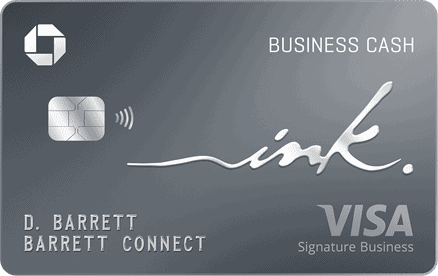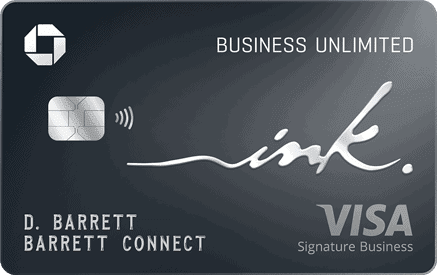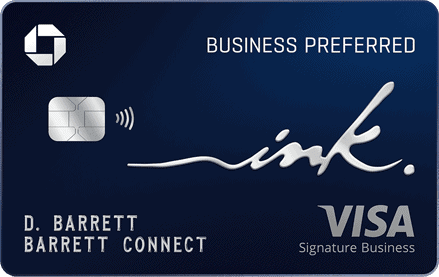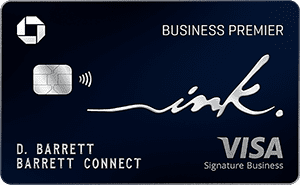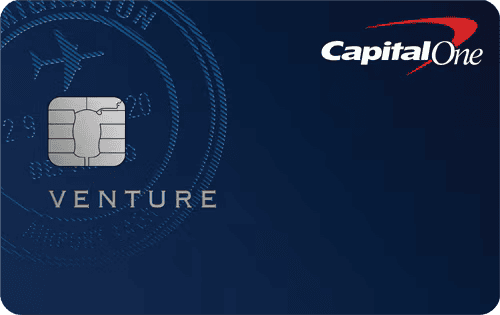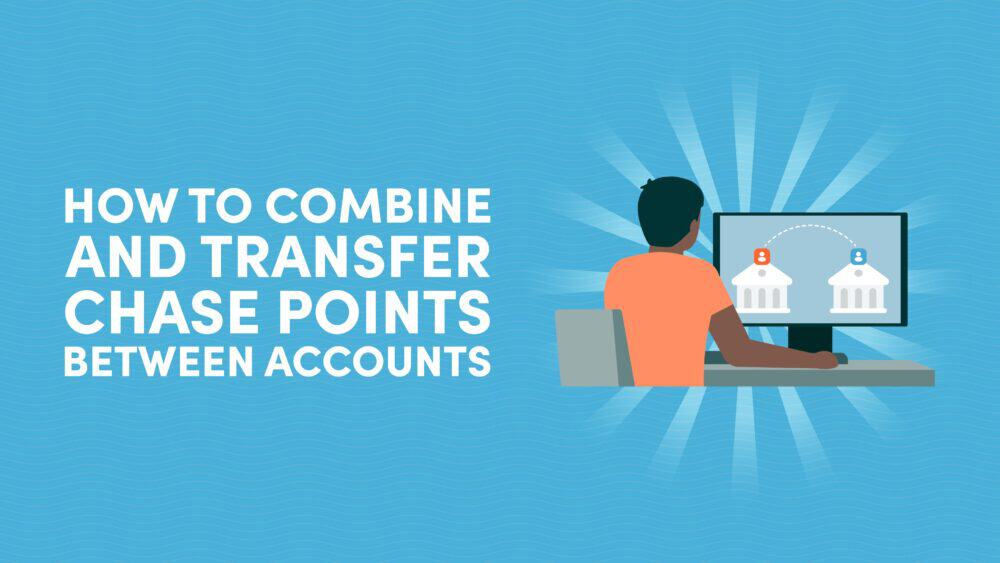
10xTravel is part of an affiliate sales network and receives compensation for sending traffic to partner sites, such as CreditCards.com. This compensation may impact how and where links appear on this site. This site does not include all financial companies or all available financial offers. Terms apply to American Express benefits and offers. Enrollment may be required for select American Express benefits and offers. Visit americanexpress.com to learn more.
Note: Some of the offers mentioned below may have changed or may no longer be available. The content on this page is accurate as of the posting date; however, some of our partner offers may have expired. You can view current offers here.
As a small business owner, finding the right business credit card can be crucial for managing expenses while also maximizing rewards. Just because you’re hard at work building your business doesn’t mean you can’t rack up some serious travel rewards along the way.
The Chase Ink business cards include four powerful cards that routinely offer enticing welcome bonuses, competitive earning categories and, most importantly, an opportunity to accumulate a ton of valuable Chase Ultimate Rewards points. The best part? You don’t need a large corporation to be eligible. As long as you generate some income on the side, Chase considers you a small business owner, making you a potential candidate for one or more Ink cards.
But with four options to choose from, which Chase Ink business card is right for your small business? Let’s dive into the features and benefits of each Ink card and help you make an informed choice that will not only boost your business but also maximize your rewards potential.

Ink Business Cash® Credit Card
It’s only fitting to begin our discussion of the Chase Ink cards with the Chase Ink Business Cash® Credit Card. Many small business owners consider the Ink Cash a top choice for its high welcome offer, strong earning categories, cardmember benefits and $0 annual fee.
Let’s explore each of these highlights, starting with the welcome offer. Generally, the Ink Business Cash offers a bonus of anywhere between $500 to $900 cash back issued as Chase points after you spend $3,000 to $6,000 in the first three months. These points can net you some amazing travel rewards, so don’t leave them on the table.
Regarding point-earning potential, the Ink Business Cash card allows you to earn 5X points on up to $25,000 per anniversary year at office supply stores, internet, cable and phone services. It also offers 2X points on up to $25,000 per anniversary year at gas stations and restaurants, and 1X everywhere else.
Chase Ink Business Cash® Credit Card
Earn $350
bonus cash back when you spend $3,000 on purchases
in the first three months and additional $400 when you spend $6,000 on purchases in the first six months after account opening
The card also offers a number of additional benefits, including primary rental car collision damage waiver on business rentals, purchase protection, extended warranty protection, baggage delay insurance, lost luggage reimbursement and employee cards at no additional cost. Despite these travel benefits, note that there’s a 3% foreign transaction fee on this card.
So to recap, the card has a high welcome offer, strong earning categories and additional benefits. What’s the catch? Incredibly, there is none. The Chase Ink Business Cash card has no annual fee, ensuring that any value you get from the card is positive value for your business.

Ink Business Unlimited® Credit Card
Next up is the Chase Ink Business Unlimited® Credit Card. This card stands out as a top contender for small business owners seeking a straightforward credit card setup while still offering decent rewards potential.
The standout feature of the Ink Unlimited is the 1.5X earning on every purchase. Unlike other cards with specific or even rotating categories, this card ensures that every transaction you make contributes to your rewards at a slightly elevated rate.
Chase Ink Business Unlimited® Credit Card
Earn $750
bonus cash back
after you spend $6,000 on purchases in the first 3 months from account opening
Many of the card’s other perks mirror those of the Ink Cash card. For instance, the Ink Unlimited also comes with an excellent welcome offer you’ll definitely want to capitalize on. Historically, the offer has been quite similar to the Ink Cash card, typicaly being identical.
The Ink Unlimited also provides additional benefits to cardholders including primary collision damage waiver on business rentals, purchase protection, extended warranty protection and the option to issue employee cards at no extra charge. Like the Ink Cash, the Ink Unlimited also charges 3% in foreign transaction fees.
Once again, you get all these perks for a whopping $0 annual fee. In summary, the Chase Ink Business Unlimited is a compelling option for small businesses seeking both simplicity and value.
Ink Business Preferred® Credit Card
Our first mid-range card in the Ink lineup is the Chase Ink Business Preferred®. This is a travel card that’s a favorite among small business owners who are looking for more substantial travel rewards and exclusive benefits.
Let’s start with the impressive welcome offer. Historically, this card has offered between 80,000 and 100,000 Chase points after spending anywhere from $6,000 to $15,000 on the card within the first three months. We admit, those high spending requirements can be pretty difficult to achieve, but if your business is able to reach them, this is one of the most valuable bonuses that Chase offers on any of their credit cards.
The Ink Business Preferred also boasts some great point-earning potential. With this card, you earn 3X on up to $150,000 per card anniversary year in a diverse range of business categories, including travel, shipping, internet, cable and phone services as well as advertising on social media and search engines. Chase has clearly tailored these categories to fit the needs of modern businesses.
Chase Ink Business Preferred® Credit Card
90,000
bonus points
after you spend $8,000 on purchases in the first 3 months after account opening.
Annual Fee: $95
Beyond the basics, the Ink Preferred also offers a host of additional benefits. For instance, it enables cardholders to get more points when you redeem for travel through Chase TravelSM.
. It also unlocks the ability for cardholders to transfer points directly to Chase’s travel partners, which is how you’ll often get outsized value for your points.
Of course, no travel card would be complete without benefits, such as trip cancellation/interruption insurance, trip delay insurance and primary collision damage waiver on business rentals. In addition, there are no foreign transaction fees with the Ink Preferred, unlike for the Ink Cash and Ink Unlimited.
The Ink Business Preferred card does come at a $95 annual fee. However, depending on your business, the benefits of the card can significantly outweigh its costs. With its enticing welcome offer, reward earning categories and travel-focused benefits, the Ink Preferred can be a great strategic addition to your wallet.
Ink Business Premier® Credit Card
Chase’s latest Ink offering, the Ink Business Premier® Credit Card, may seem like a premium version of the Ink Unlimited card at first glance. However, as we’ll soon see, the card does come with some peculiar nuances that make it the odd one out in the Chase Ink lineup.
The Ink Business Premier card earns an unlimited 2% cash back on all purchases and unlimited 2.5% cash back on purchases of $5,000 or more. It also earns 5% back on travel purchased through the Chase travel portal. Overall, this appears to one-up the Ink Unlimited, which offers 1.5X back on all purchases.
Ink Business Premier® Credit Card
$1,000
Bonus cash back
after you spend $10,000 on purchases in the first 3 months from account opening.
Annual Fee: $195
However, the Ultimate Rewards points that you earn with the Ink Premier are not the Ultimate Rewards points you know and love. Notably, they can’t be combined with points earned from your other Chase accounts, and they can’t be transferred to travel partners. Essentially fixed at 1 cent per point, they’re equivalent to regular cash back (this is why we denote that the card earns 2% cash back rather than 2X points).
This likely limits the value of the card for many travel enthusiasts. Still, there are good reasons to get the card. For instance, the Ink Premier typically offers a welcome bonus worth $1,000 after spending $10,000 in the first three months. That amount of cash back is nothing to scoff at.
Also, although the card is less travel-focused, it still offers perks like trip cancellation/interruption insurance, primary collision damage waiver and no foreign transaction fees. The other main benefit is the Flex for Business feature, which allows business owners to pay off eligible charges over several months with interest.
Overall, at a $195 annual fee, the Ink Premier is a bit harder to justify given how compelling the other three Ink cards are. However, this all still greatly depends on your business’s typical spending patterns. We’ll consider more specific reasons to choose this card later in the article, after we provide a summary of what we’ve discussed so far.

The Chase Ink Preferred comes with cell phone protection, one of its many perks for cardholders
Chase Ink Cards: A Summary
Here’s a handy table that summarizes the main points of each card.
| Ink Business Cash | Ink Business Unlimited | Ink Business Preferred | Ink Business Premier | |
|---|---|---|---|---|
| Annual fee | $0 | $0 | $95 | $195 |
| Earning categories | • 5X at office supply stores, internet, cable and phone services (first $25,000 per anniversary year) • 2X at gas stations, restaurants (first $25,000 per anniversary year) • 1X on all other purchases | • 1.5X on all purchases (unlimited) | • 3X on travel, shipping, internet, cable and phone services. advertising on social media and search engines (first $150,000 per anniversary year) • 1X on all other purchases | • 5% on travel purchased through Chase Travel℠ • 2.5% on purchases of $5,000 or more • 2% on all other purchases |
| Benefits | • Primary rental car CDW • Purchase protection • Extended warranty protection • Baggage delay insurance • Lost luggage reimbursement • Additional employee cards at no cost | • Primary rental car CDW • Purchase protection • Extended warranty protection • Baggage delay insurance • Lost luggage reimbursement • Additional employee cards at no cost | • Primary rental car CDW • Purchase protection • Extended warranty protection • Baggage delay insurance • Lost luggage reimbursement • Additional employee cards at no cost • Trip cancellation and interruption insurance • Cell phone protection • Trip delay insurance • No foreign transaction fees • Points can be transferred to partners • Points are worth more when you redeem for travel through Chase TravelSM | • Primary rental car CDW • Purchase protection • Extended warranty protection • Baggage delay insurance • Additional employee cards at no cost • Trip cancellation and interruption insurance • Cell phone protection |
| Other important notes | • Has a 3% foreign transaction fee | • Has a 3% foreign transaction fee | • Earns Ultimate Rewards points, but can’t transfer to partners or combine them with points earned in other Chase accounts |

Which Ink Card Is Best For You?
Now that we’ve got a good idea of what each card offers, let’s try to determine which one is best for your business based on what you might value most.
Annual Fees
If you don’t want to pay any annual fees, your choices narrow down to two cards: the Ink Cash and the Ink Unlimited. Both cards charge $0 annual fees and still offer great value.
Earning Categories
One great thing about the Chase Ink cards is that there’s almost no overlap between the bonus categories. This means that you could simply tailor your card selection to the categories in which your business spends the most.
If you frequently spend at office supply stores, then the Ink Cash card is a perfect choice. For businesses that are heavily invested in social media advertising, the Ink Preferred card might be the right fit. If your spending varies across many categories, the Ink Unlimited card offers a simple and versatile rewards structure.
Note that while the Ink cards don’t really overlap categories among themselves, there are some overlaps with the Chase personal cards. (More on this later.)
Welcome Offers
All of the Chase Ink welcome offers are top notch, and you can’t go wrong with any of them. For smaller businesses and sole proprietorships, the only thing to watch out for are the spending requirements.
Typically, Chase sets higher welcome offer requirements on the Ink cards than the personal cards. However, the thresholds are more achievable for the Ink Cash and the Ink Unlimited cards, usually requiring around $6,000 within the first three months. In contrast, the Ink Preferred and the Ink Premier cards have higher thresholds, often requiring $8,000 to $10,000 in spending in the first three months.
Given the value of these welcome offers, it’s important to select a card with spending requirements that you can comfortably meet.
Consumer and Travel Benefits
When it comes to consumer benefits, all four Ink cards are just about equal. You get purchase protection and extended warranty protection on all cards. The only difference is with chase cell phone protection, which is exclusive to the Ink Preferred and the Ink Premier cards.
If you care a lot about travel benefits, the Ink Preferred is your best bet. It’s a fully fledged travel card, so it comes with every type of travel insurance you could want to protect you on your next business trip.
The other cards have fewer travel benefits, but we’d argue that they’d still do fine for domestic travel. Outside of the United States, you’ll definitely not want to use the Ink Cash or the Ink Unlimited because those come with foreign transaction fees. The Ink Premier card has no foreign transaction fees, but it also has a much shorter list of travel benefits and double the annual fee.
Overall Ease of Use
Running a business is demanding, so choosing a card that’s easy to use might also be an important factor.
Ease of use could refer to the earning categories. Are you inclined to remember to use the right card at the right place to maximize your earnings, or would you rather opt for an easier, catch-all approach with the Ink Unlimited and Ink Premier?
Ease of use could also involve the consideration of justifying annual fees. Do you want to spend time each year re-evaluating whether the Ink Preferred or Ink Premier is worth their respective annual fees? Or would you rather just go for the easier $0 annual fee cards instead (Ink Cash and Ink Unlimited)?
The bottom line is, while the more complicated cards may be able to offer better value, it can also take more effort on your part to extract that value.

Special Considerations
We talked about some typical considerations in the last section. Now, let’s put some of these cards against each other and also dive a bit deeper into some more special questions and considerations.
Ink Cash vs. Ink Unlimited
We anticipate that some business owners may have trouble deciding between the two $0 annual fee options in the Ink Cash and the Ink Unlimited. So, let’s put them up for debate.
Practically, these cards are similar in almost every category besides the earning categories. It comes down to whether your business can take advantage of the 5X and 2X categories on the Ink Cash. In other words, if your business spends a lot at office supply stores, internet, cable, phone services, gas stations and restaurants, you’ll come out ahead. Otherwise, if your business primarily spends outside of those categories, then the Ink Unlimited will get you better value.
The easiest way to determine which card is better is to simply review your current business spending, and then calculate how many points you’d earn on each card. For example, let’s suppose that in the past year, your business spent the following (multiplier for the Ink Cash in parentheses):
- $1,000 at office supply stores (5X)
- $2,000 on internet (5X)
- $2,000 at restaurants (2X)
- $15,000 on miscellaneous purchases (1X)
For this spend, you’d earn 34,000 Chase Ultimate Rewards points with the Ink Cash card, compared to 30,000 points with the Ink Unlimited. Since the Ink Cash comes out on top, you might opt for this card if your business spending remains similar.
There’s a subtle nuance, though, when your business has high spending in the 5X categories. You get 5X back on just the first $25,000 worth of spending per year, so any spending beyond $25,000 earns just 1X back. This limit means that theoretically there’s a threshold at which the unlimited 1.5X on the Ink Unlimited card actually beats the limited 5X on the Ink Cash card.
To find this exact threshold, we can let x represent the amount of spend over $25,000 and solve for x in the following formula:
5(25,000) + 1(x) = 1.5(25,000 + x)
x = 175,000
In practical terms, your business would have to spend over $200,000 (175,000 + 25,000) in the 5X category for the Ink Unlimited to be a better choice for your business. However, such high spending in the 5X category is uncommon for most small businesses.
Ink Unlimited vs. Ink Premier
Another interesting debate is between the Ink Unlimited and the Ink Premier because of their similar rewards structures. The Ink Premier card offers better catch-all multipliers but comes with a $195 annual fee. If you’re running a one-card setup, at which point does it make more sense to go for the Ink Premier over the Ink Unlimited?
Again, we can use math to figure this out. First of all, let’s compare apples to apples by assuming the Ink Unlimited card also earns cash back (so 1.5% instead of 1.5X). Let’s also assume that none of your purchases are over $5,000, allowing us to focus solely on the Ink Premier’s 2% earning rate vs. the Ink Unlimited’s 1.5%.
If y represents the amount of spend, let’s solve for y in the following formula:
2(y) – 19,500 = 1.5(y)
y = 39,000
This means that $39,000 worth of spending is the breakeven point for both cards. With the Ink Unlimited, you’d have $585 cash back at this point. With the Ink Premier, you’d have $780 cash back, but after subtracting the $195 annual fee, your net rewards would also amount to $585.
So, our first conclusion is that if your business spends above $39,000, it makes more sense to choose the Ink Premier card over the Ink Unlimited card.
However, what if your business can take advantage of the special 2.5% category on the Ink Premier? Let’s work out the math in that case, using z to represent the amount of spending:
2.5(z) – 19,500 = 1.5(z)
z = 19,500
This means that if your business can make a single huge purchase of at least $19,500, this is another breakeven point for both cards. With the Ink Unlimited card, you’d have $292.50 in cash back after such a purchase. With the Ink Premier, you’d have $487.50, but after subtracting the $195 annual fee, you’d also be $292.50 in the green.
Our second conclusion is that if your business can spend more than $19,500 in the 2.5% back category, the Ink Premier makes more sense over the Ink Unlimited.
Remember, both of these conclusions assumed that both cards earned cash back. In practice, this isn’t really the case: the Ink Unlimited earns true Chase Ultimate Rewards points, which can potentially be worth significantly more than cash back. In contrast, Ultimate Rewards points earned by the Ink Premier are essentially capped at 1 cent per point of value. Thus, your willingness to accept the “inferior” Chase points is an additional factor to consider.

To Ink Preferred or Not?
In the previous two debates, we left out the Ink Preferred card. It’s difficult to compare the Ink Preferred to the other three because as the only real travel card, it’s basically in a league of its own. The question is not how it compares to the other cards, but whether it’s a suitable choice for your business and if the $95 annual fee is justified.
One of the best features that separates the Ink Business Preferred Card from the competition is the fact that if you have the Ink Business Preferred Card in your wallet, your rewards points are worth more when redeemed for travel through the Chase Travel℠ portal.
It’s worth noting that you can often get even more value out of your Chase points than you can from the portal by transferring them to partner travel programs. However, this is more time-consuming and complicated than redeeming for travel through Chase Travel℠. So, if you want to keep things simple and easy and still get good value, then redeeming for travel through Chase Travel℠ is not a bad option with the Ink Business Preferred.
However, there are also qualitative features on the card that are much harder to quantify. For instance, the ability to transfer to travel partners is a valuable perk, but different businesses will value that differently.
Overall, you’re going to have to use a combination of quantitative and qualitative assessments to determine whether the Ink Preferred card is worth it for you. That involves looking at both the earning categories as well as the extra travel benefits it gives you.
What Chase Personal Cards Do You Have?
In this article, we largely steered clear of the personal Chase cards to compare the Ink Business cards on their own. In reality, the consumer cards in your wallet can impact which Ink card is the best choice.
Take the Ink Cash card for example—it earns 2% at restaurants. In the Ink world, this is the highest multiplier for restaurants, but many of the Chase personal cards can easily beat that. For example, the $0 annual fee Chase Freedom Unlimited® earns 3% back on dining at restaurants.
Another example relates to the Ink Preferred card. While we highlighted its perk of transferring points directly to partners, this benefit is already available to members of the popular Chase Sapphire Preferred® Card or the Chase Sapphire Reserve®.
In fact, this enhanced redemption value through Chase Travel℠ is also a feature of the premium personal cards. Both the Sapphire Preferred and the Sapphire Reserve now use a “Points Boost” system for select travel, which could make the Ink Preferred’s similar perk redundant.
In conclusion, it’s good to take inventory of the perks and earning categories you already enjoy with your Chase personal cards. Avoid overlapping too many benefits and focus on the Ink card that complements your existing card benefits.
Chase 5/24 Status
Last but not least, always keep the Chase 5/24 rule in the back of your mind. If you’ve opened five or more consumer credit cards (from any issuer) in the past 24 months, Chase is likely to deny your application for a new Chase card.
However, while Chase considers your 5/24 status when applying for an Ink card, Ink cards themselves don’t count towards your 5/24 status. For example, if you’re at 4/24 and you get approved for an Ink card, you’d still be at 4/24.
Final Thoughts
Each of the Chase Ink business cards has the potential to be an excellent addition to your wallet, offering enticing welcome offers, earning categories and benefits. However, there’s no need to limit yourself to just one Ink card. With the variety of rewards available, why settle for just one?
If you’re still feeling stuck, consider starting with both the Ink Cash and the Ink Unlimited cards, especially since they have no annual fees. Thus, you can use the cards when it makes sense and let them sit there otherwise. As your business grows and evolves, you may find it beneficial to explore the Ink Preferred and the Ink Premier cards then.
Additional Articles You Might Be Interested In:
New to the world of points and miles? The Chase Sapphire Preferred® Card is the best card to start with.
With a bonus of 75,000 bonus points after you spend $5,000 on purchases in the first 3 months from account opening. , 5x points on travel booked through Chase Travel℠ and 3x points on restaurants, streaming services, and online groceries (excluding Target, Walmart, and wholesale clubs), this card truly cannot be beat for getting started!
in the first three months and additional $400 when you spend $6,000 on purchases in the first six months after account opening
after you spend $6,000 on purchases in the first 3 months from account opening
after you spend $8,000 on purchases in the first 3 months after account opening.
after you spend $10,000 on purchases in the first 3 months from account opening.
Editors Note: Opinions expressed here are author’s alone, not those of any bank, credit card issuer, hotel, airline, or other entity. This content has not been reviewed, approved or otherwise endorsed by any of the entities included within the post.



